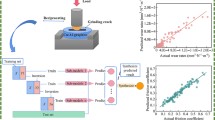Abstract
A new computer-aided method is described for measuring and recording quenching intensity under workshop conditions using a special cylindrical probe. The method is based on measuring the temperature gradient at the probe surface and representing the quenching intensity as heat flux density. The method is applicable for different quenchants, quenching conditions, and quenching techniques, and enables the comparison of the real quenching intensity among them. The technique is sensitive enough to reflect a change in each quenching parameter.
A test specimen made of the steel grade of interest is hardened under the same quenching conditions as round bars of different diameters made of the same steel grade, in order to predict the hardness distribution across such bars. This computer-aided prediction is based on Jominy hardenability data, quenching intensity characteristics, and hardness distribution data obtained by quenching test specimens—all stored in the computer memory. Using equations from a regression analysis of Crafts-Lamont diagrams, software was developed for precise prediction of the hardness distribution in quenched bars. Predicted values are compared with experimentally obtained results.
Similar content being viewed by others
References
Liscic B.: The Temperature Gradient at the Surface As An Indicator of the Real Quenching Intensity During Hardening,Häterei Tech. Mitt. 33 (1978) No. 4, pp. 179–191.
Liscic, B.: Practical Measurement of the Quenching Intensity by the Temperature Gradient on the Surface of a Special Cylindrical Probe, Proceedings of the 18th International Conference on Heat Treatment of Materials, May 1980, Detroit, MI, American Society for Metals, pp. 51–63.
Hengerer F., Strassle B., Bremi P.: Calculation of the Cooling Process in Oil and in Hardening Cylindrical and Plate Work Pieces of Alloyed Steel With the Aid of An Electronic Computer,Stahl and Eisen 89, 1969, No. 12, pp. 641–654.
Kobasko, N.I.: Thermal Processes in Steel Quenching,Metallovedenie i termiceskaja obrabotka metallov, No. 3, 1968.
Asimov M., Craig W.F., and Grossman M.A.: Correlation Between Jominy Test and Quenched Rounds,Transactions SAE, Vol. 49 (1941), pp. 283–293.
Crafts, W. and Lamont, J.L.:Hardening Capability and Selection of Steel, Springer-Verlag (1954).
Just, E.: Heat Treatment, Effect of Material on Hardening and Tempering,VDI Berichte No. 256 (1976), pp. 125–140.
Gerber, W. and Wyss, U.: Hardening and Heat Treatment Capability of Steels,Von Roll Mitteilungen 7, Jahrgang No. 2/3, Juni/September 1948, pp. 13–49.
Author information
Authors and Affiliations
Rights and permissions
About this article
Cite this article
Liscic, B., Filetin, T. Computer-aided evaluation of quenching intensity and prediction of hardness distribution. J. Heat Treating 5, 115–124 (1988). https://doi.org/10.1007/BF02833177
Issue Date:
DOI: https://doi.org/10.1007/BF02833177




